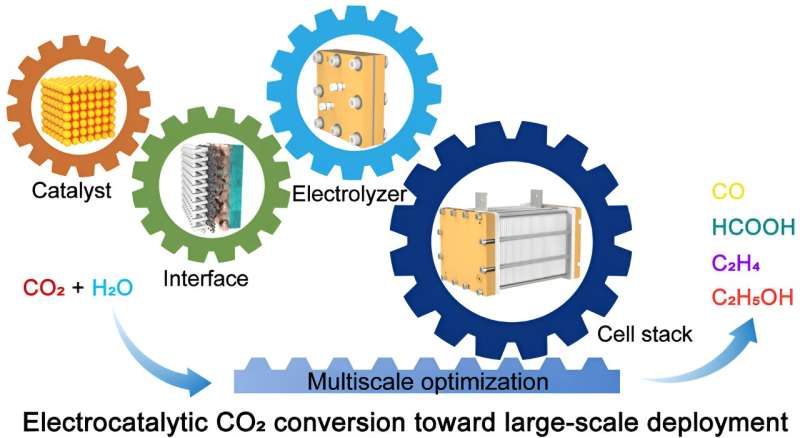This article has been reviewed according to Science X's editorial process and policies. Editors have highlighted the following attributes while ensuring the content's credibility:
fact-checked
trusted source
proofread
Electrocatalytic CO₂ conversion advancing toward large-scale deployment

Global CO2 emissions continue to grow, reaching 36.1 Gt in 2022, stimulating the implementation of carbon taxes and impacting energy use. The electrocatalytic CO2 reduction reaction (CO2RR) to produce high value-added chemicals and liquid fuels contributes to the construction of green chemical engineering and carbon neutrality.
Decades of research, as well as advances in catalyst design and electrolyzer engineering at the laboratory scale, promise the large-scale deployment of CO2 electrolysis technology.
For practical applications, electrocatalytic CO2RR needs to be executed in a full cell, which unfortunately suffers from low CO2 conversion, poor activity, and stability at the laboratory-scale under industry relevant current densities (> 200 mA cm-2). Consequently, ensuring sufficient production efficiency to reduce product separation costs and electricity consumption is challenging.
To further establish a large-scale CO2 electrolysis system, two dimensions need to be considered: increasing the unit area and quantity of electrode. However, both of them usually bring out a pronounced amplification effect dictated by the complex multi-field coupling, including but not limited to the electric field, reaction field, and flow field. This effect leads to a decrease in the reaction performance and lifetime, ultimately limiting the implementation of industrial CO2 electrolysis with economic benefits.
Recently, a research team led by Prof. Ye Wang and Prof. Shunji Xie from Xiamen University, China, provided significant insights into the electrocatalytic conversion of CO2 for large-scale deployment. Their work has been published in the Chinese Journal of Catalysis
This study offers a comprehensive overview of the multi-scale interlinked research process, with the aim of advancing the commercial application of CO2 electrolysis. The team highlights the challenges involved in realizing high-efficiency CO2 conversion, drawing on the latest research results.
They also examine the future prospects of electrocatalytic CO2 conversion, focusing on the key issues that need to be addressed for its commercial application.
The work points out that while large-scale electrolysis is currently unfeasible, the CO2 electrocatalytic conversion technology and its supporting facilities are advancing rapidly. This progress is accompanied by a decrease in the cost of renewable electric energy.
The researchers emphasize the importance of optimizing the technology from a comprehensive perspective and addressing key issues at different scales involving catalyst, interface, electrolyzer, and cell stack. Focusing on a single aspect is unlikely to achieve the desired results.
Once the roadblocks are overcome, especially in terms of energy conversion efficiency (ECE) and lifetime, CO2 electrolysis will soon become commercially available. However, they also note that the CO2 electrolysis technology is still in its early stage of large-scale applications.
More information: Li Lin et al, Electrocatalytic CO2 conversion toward large-scale deployment, Chinese Journal of Catalysis (2023). DOI: 10.1016/S1872-2067(23)64524-3
Provided by Chinese Academy of Sciences





















